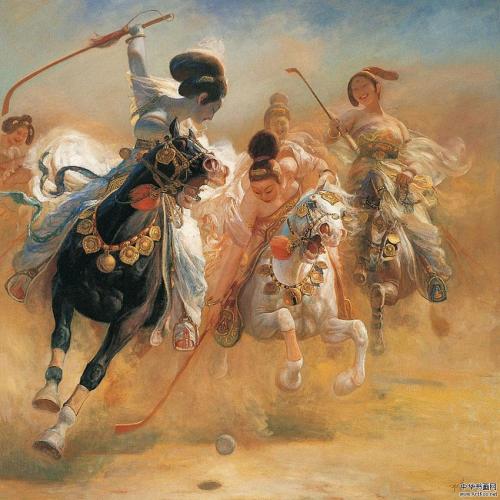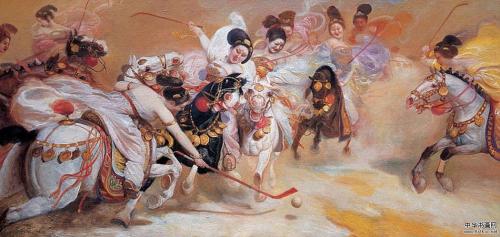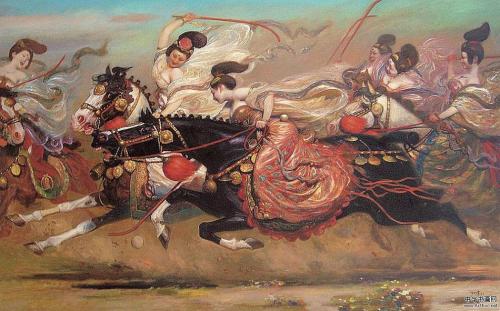siumerghe:Tang dynasty women playing polo, paintings by Wang KeweiThe word polo is thought to derive
siumerghe:Tang dynasty women playing polo, paintings by Wang KeweiThe word polo is thought to derive from the Tibetan pulu, the wood from which the ball was made. Much controversy surrounds the origin of polo. Tibet, China, Iran, India, and Central Asia have all been proposed as homelands for the game. It remains possible that the game had more than one point of origin, though a recent study has argued convincingly that polo developed in northeastern Iran out of the equestrian chase games played by the mounted nomads of Central Asia in the last centuries before the Common Era.Polo probably was introduced to China sometime between the end of the Han period (206 B.C.E.- 220 C.E.) and the early part of the Tang dynasty (618-907). It seems likely that it was introduced by the Xianbei tribes that controlled northern China from the fourth to sixth century. The ruling house of the Tang dynasty, the Li family, itself had Xianbeiancestry, at least on the maternal side. The Xianbei, because of their nomadic origins, had a great fondness for horses, a trait that (like many aspects of their culture) was inherited by the Tang dynasty. It is also notable that the Xianbei accorded higher status and more physical freedom to women than the Han Chinese, so women became avid polo players under the Tang dynasty.The emperors of the Tang dynasty such as Zhongzong, Xuanzong, Muzong, Jingzong, Xuanzong, Xizong, and Zhaozong were all supporters and participants themselves in the polo sport. In the 6th year of the Tianbao era (747), Emperor Tang Xuanzong issued a special order, and declared that polo would become one of the subjects for military training.Polo was wildly popular during the Tang dynasty but it was also dangerous; riders thrown from their horses were frequently injured or killed. So sometimes donkeys were used instead of horses - as a safer alternative.The Tang era terracotta figurines of polo players, both male and female, were unearthed in China. The game is also depicted on paintings and on frescoes in excavated tombs. From Tang times on, the education of the upper class became more bookish, and martial skills, such as horsemanship, archery, and swordsmanship, came to play a lesser role in the elite life. So polo also gradually lost its popularity and completely fade away by the Qing dynasty. Women stopped playing polo much earlier - when the conservative Neo-Confucian teaching grew in popularity after the Tang dynasty fall. For women, Neo-Confucianism placed extra emphasis on chastity, obedience and diligence. A good wife should have no desire other than to serve her husband, no ambition other than to produce a son, and no interest beyond subjugating herself to her husband’s family. Of course, this left no space for physical training, horsemanship and sport.https://sites.asiasociety.org/arts/asiangames/power02.html -- source link
#china#chinese fashion#tang dynasty#riding habit


